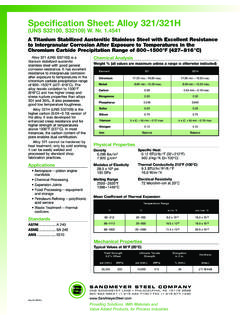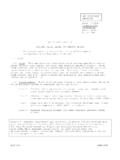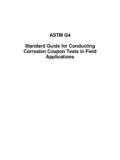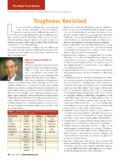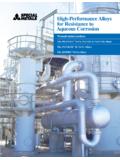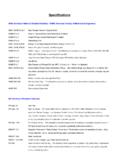Transcription of Standard Practices for Detecting Susceptibility to ...
1 Designation: A 262 02aStandard Practices forDetecting Susceptibility to intergranular Attack in AusteniticStainless Steels1 This Standard is issued under the fixed designation A 262; the number immediately following the designation indicates the year oforiginal adoption or, in the case of revision, the year of last revision. A number in parentheses indicates the year of last reapproval. Asuperscript epsilon (e) indicates an editorial change since the last revision or Standard has been approved for use by agencies of the Department of Scope* These Practices cover the following five A Oxalic Acid Etch Test for Classificationof Etch Structures of Austenitic Stainless Steels (Sections 3 to7, inclusive), B Ferric Sulfate Sulfuric Acid Test forDetecting Susceptibility to intergranular Attack in AusteniticStainless Steels (Sections 8 to 14, inclusive)
2 , C Nitric Acid Test for Detecting Suscepti-bility to intergranular Attack in Austenitic Stainless Steels(Sections 15 to 21, inclusive), E Copper Copper Sulfate Sulfuric AcidTest for Detecting Susceptibility to intergranular Attack inAustenitic Stainless Steels (Sections 22 to 31, inclusive), F Copper Copper Sulfate 50 % SulfuricAcid Test for Detecting Susceptibility to intergranular Attackin Molybdenum-Bearing Cast Austenitic Stainless Steels (Sec-tions 32 to 38, inclusive). The following factors govern the application of Susceptibility to intergranular attack associated withthe precipitation of chromium carbides is readily detected in allsix Sigmaphaseinwroughtchromium-nickel-molyb denum steels, which may or may not be visible in themicrostructure, can result in high corrosion rates only in Sigma phase in titanium or columbium stabilizedalloys and cast molybdenum-bearing stainless alloys, whichmay or may not be visible in the microstructure.
3 Can result inhigh corrosion rates in both the nitric acid and ferric sulfate- sulfuric acid The oxalic acid etch test is a rapid method of identify-ing, by simple etching, those specimens of certain stainlesssteel grades that are essentially free of Susceptibility tointergranular attack associated with chromium carbide precipi-tates. These specimens will have low corrosion rates in certaincorrosion tests and therefore can be eliminated (screened) fromtesting as acceptable. The ferric sulfate sulfuric acid test, the copper coppersulfate 50 % sulfuric acid test, and the nitric acid test are basedon weight loss determinations and, thus, provide a quantitativemeasure of the relative performance of specimens evaluated.
4 Incontrast, the copper copper sulfate 16 % sulfuric acid test isbased on visual examination of bend specimens and, therefore,classifies the specimens only as acceptable or In most cases either the 24-h copper copper sul-fate 16 % sulfuric acid test or the 120-h ferric sulfate sulfuricacid test, combined with the oxalic acid etch test, will providethe required information in the shortest time. All stainlessgrades listed in the accompanying table may be evaluated inthese combinations of screening and corrosion tests, exceptthose specimens of molybdenum-bearing grades (for example316, 316L, 317, and 317L)
5 , which represent steel intended foruse in nitric acid The 240-h nitric acid test must be applied to stabilizedand molybdenum-bearing grades intended for service in nitricacid and to all stainless steel grades that might be subject to endgrain corrosion in nitric acid Only those stainless steel grades are listed in Table 1 forwhich data on the application of the oxalic acid etch test and ontheir performance in various quantitative evaluation tests Extensive test results on various types of stainless steelsevaluated by these Practices have been published in Ref(1). The values stated in SI units are to be regarded asstandard.
6 The inch-pound equivalents are in parentheses andmay be Standard does not purport to address all of thesafety problems, if any, associated with its use. It is theresponsibility of the user of this Standard to establish appro-priate safety and health Practices and determine the applica-bility of regulatory limitations prior to use.(Specific precau-tionary statements are given in , , , and )1 These Practices are under the jurisdiction of ASTM Committee A01 on Steel,Stainless Steel and Related Alloys and are the direct responsibility of on Methods of Corrosion edition approved Nov.
7 10, 2002. Published December 2002. Originallyapproved in 1943. Last previous edition approved in 2002 as A 262 boldface numbers in parentheses refer to the list of references found at theend of these *A Summary of Changes section appears at the end of this ASTM International, 100 Barr Harbor Drive, PO Box C700, West Conshohocken, PA 19428-2959, United Referenced Standards:A 370 Test Methods and Definitions for Mechanical Testingof Steel Standard :ISO 3651-2 Determination of Resistance to IntergranularCorrosion of Stainless Steels Part 2: Ferritic, Austenitic,and Ferritic-Austenitic (Duplex) Stainless Steels Corrosion Test in Media Containing Sulfuric Acid4 PRACTICE A OXALIC ACID ETCH TEST FORCLASSIFICATION OF ETCH STRUCTURES OFAUSTENITIC STAINLESS STEELS 23.
8 The oxalic acid etch test is used for acceptance ofmaterial but not for rejection of material. This may be used inconnection with other evaluation tests to provide a rapidmethod for identifying those specimens that are certain to befree of Susceptibility to rapid intergranular attack in these othertests. Such specimens have low corrosion rates in the varioushot acid tests, requiring from 4 to 240 h of exposure. Thesespecimens are identified by means of their etch structures,which are classified according to the following The oxalic acid etch test may be used to screenspecimens intended for testing in Practice B Ferric Sulfate- Sulfuric Acid Test, Practice C Nitric Acid Test, PracticeE Copper Copper Sulfate 16 % Sulfuric Acid Test, andPractice F Copper Copper Sulfate 50 % Sulfuric Acid Each practice contains a table showing which classi-fications of etch structures on a given stainless steel grade areequivalent to acceptable.
9 Or possibly nonacceptable perfor-mance in that particular test. Specimens having acceptable etchstructures need not be subjected to the hot acid test. Specimenshaving nonacceptable etch structures must be tested in thespecified hot acid The grades of stainless steels and the hot acid tests forwhich the oxalic acid etch test is applicable are listed in Extra-low carbon grades, and stabilized grades, such as304L, 316L, 317L, 321, and 347, are tested after sensitizingheat treatments at 650 to 675 C (1200 to 1250 F), which is therange of maximum carbide precipitation.
10 These sensitizingtreatments must be applied before the specimens are submittedto the oxalic acid etch test. The most commonly used sensitiz-ing treatment is1hat675 C (1250 F).4. of Direct Current Battery, generator, or recti-fier capable of supplying about 15 V and 20 Range 0 to 30 A (Note 1). Resistance(Note 1). A cylindrical piece of stainless steel or,preferably, a 1-qt ( ) stainless steel Book of ASTM Standards, Vol from International Organization for Standardization (ISO), 1, rue deVaremb , Case postale 56 CH-1211 Geneva 20, 1 Application of Evaluation Tests for Detecting Susceptibility to intergranular Attack in Austenitic Stainless SteelsNOTE1 For each corrosion test, the types of Susceptibility to intergranular attack detected are given along with the grades of stainless steels in whichthey may be found.
